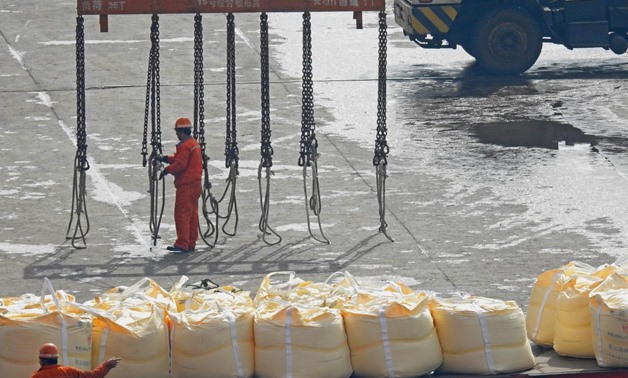
Workers pile up sacks of soda ash to be exported at a port in Lianyungang, Jiangsu province, China April 13, 2018. China Daily via REUTERS
BEIJING - 15 May 2018: China reported weaker-than-expected investment and retail sales in April and a drop in home sales, clouding its economic outlook even as policymakers try to navigate debt risks and defuse a heated trade row with the United States.
Fixed asset investment grew the slowest since 1999 while the pace of retail sales softened to a four-month low, suggesting a long-anticipated slowdown in the world’s second-largest economy may finally be setting in even as protectionism is on the rise.
The lone bright spot on Tuesday’s activity data was industrial output, which jumped more than expected as automobile and steel production surged.
“Industrial activity was buoyed by the easing of pollution controls (imposed over the winter). But there are signs in the rest of today’s data that the economy is losing momentum,” Capital Economics senior China Economist Julian Evans-Pritchard wrote in a note following the data.
“Domestic spending is likely to continue to soften given the headwinds from slowing credit creation,” he said, adding that the rebound in industry may be short-lived once companies rebuild inventories which were depleted in recent months.
Capital Economics has long predicted Beijing will loosen monetary policy later this year to keep growth from slowing too sharply as it continues a crackdown on financial risks.
Industrial output rose 7.0 percent in April, the National Bureau of Statistics said, beating forecasts for a rise of 6.3 percent and up from a seven-month low of 6.0 percent in March.
NO TRADE HIT YET
Sino-U.S. trade frictions have yet to show an impact on China’s economy, the statistics bureau said.
But while April exports and imports were surprisingly solid, business surveys point to a sharp weakening in export order growth, possibly as companies grow worried about being stuck with high inventories if the U.S. and China start imposing tit-for-tat tariffs.
Analysts also suspect some firms may be rushing out shipments to beat any punitive trade measures, flattering the most recent export figures but blunting future gains.
Washington and Beijing will resume trade negotiations this week, after initial talks earlier this month appeared to make little progress in narrowing their differences.
SLOWING INVESTMENT, SOFTENING DEMAND
Investment growth slowed pretty much across the board, adding to views that rising borrowing costs — a byproduct of the regulatory crackdown on riskier lending — are finally starting to drag on activity.
Fixed-asset investment growth slowed to 7.0 percent in January-April from a year earlier, versus forecasts of only a slight dip to 7.4 percent. Growth in April cooled to around 6 percent, analysts estimated.
Private sector investment growth moderated to 8.4 percent, from 8.9 percent in the first three months. Private investment accounts for about 60 percent of overall investment in China and has rebounded this year as spending by heavily-indebted state firms slows.
Growth in infrastructure spending, a powerful economic driver last year, slowed to 12.4 percent in the first four months from 13 percent earlier in the year.
That trend is likely to continue as Beijing forces local governments to scale back spending to contain their debt, and as home sales cool due to strict government controls to fight speculation and tame home prices.
China’s property market, another key growth driver, is also showing signs of fatigue as mortgage rates rise.
Real estate investment rose 10.2 percent in April on-year, slowing from a 10.8 percent rise in March, according to Reuters calculation based on the official data.
Property sales by floor area fell 4.1 percent in April, the biggest drop in six months, compared with a 3.2 percent rise in March. New construction starts also slowed sharply.
For the first four months of the year, sales grew just 1.3 percent.
The property slowdown is weighing on consumption, filtering through to weaker demand for home appliances and furniture.
Retail sales growth slowed to 9.4 percent in April, missing forecasts for a 10.0 percent gain and off March’s pace of 10.1 percent.
SLOWDOWN
While China’s official data suggests economic growth has been remarkably steady at 6.8-6.9 percent over the past year,
analysts have stuck to their forecasts that it will gradually lose steam in coming months, even without any trade shocks.
Economists polled by Reuters expect a slowdown to around 6.5 percent this year, which is also the government’s target.
But a few China watchers believe activity has already slackened much more, although they are in the minority.
UK-based Fathom Consulting’s momentum gauge ended the first quarter at 5.9 percent, while Capital Economics reckons growth slowed to 4.8 percent at the start of 2018 as policy tightened.
With trade frictions rising, there are signs that Beijing is already moving to a more supportive policy stance to ensure growth doesn’t slow too much.
The politburo, a top decision-making body of the Communist Party, said in April China will strive hard to achieve 2018 economic targets and will boost domestic demand.
The central bank last month unexpectedly cut reserve requirement ratios (RRR) for most banks hours after soft March data, a move that was earlier and more aggressive than expected.
While the central bank insists it has not shifted its “neutral” policy stance, economists believe further RRR cuts are likely as policymakers look to offset the impact on companies from higher financing costs and any trade fallout.
Nomura believes Beijing will continue special lending programs to support homebuyers in smaller cities and speed up its fiscal spending.
The weighted average lending rate for non-financial firms, a key indicator reflecting corporate funding costs, rose 22 basis points in the first quarter to 5.96 percent, the People’s Bank of China said in its quarterly report on Friday.


Comments
Leave a Comment